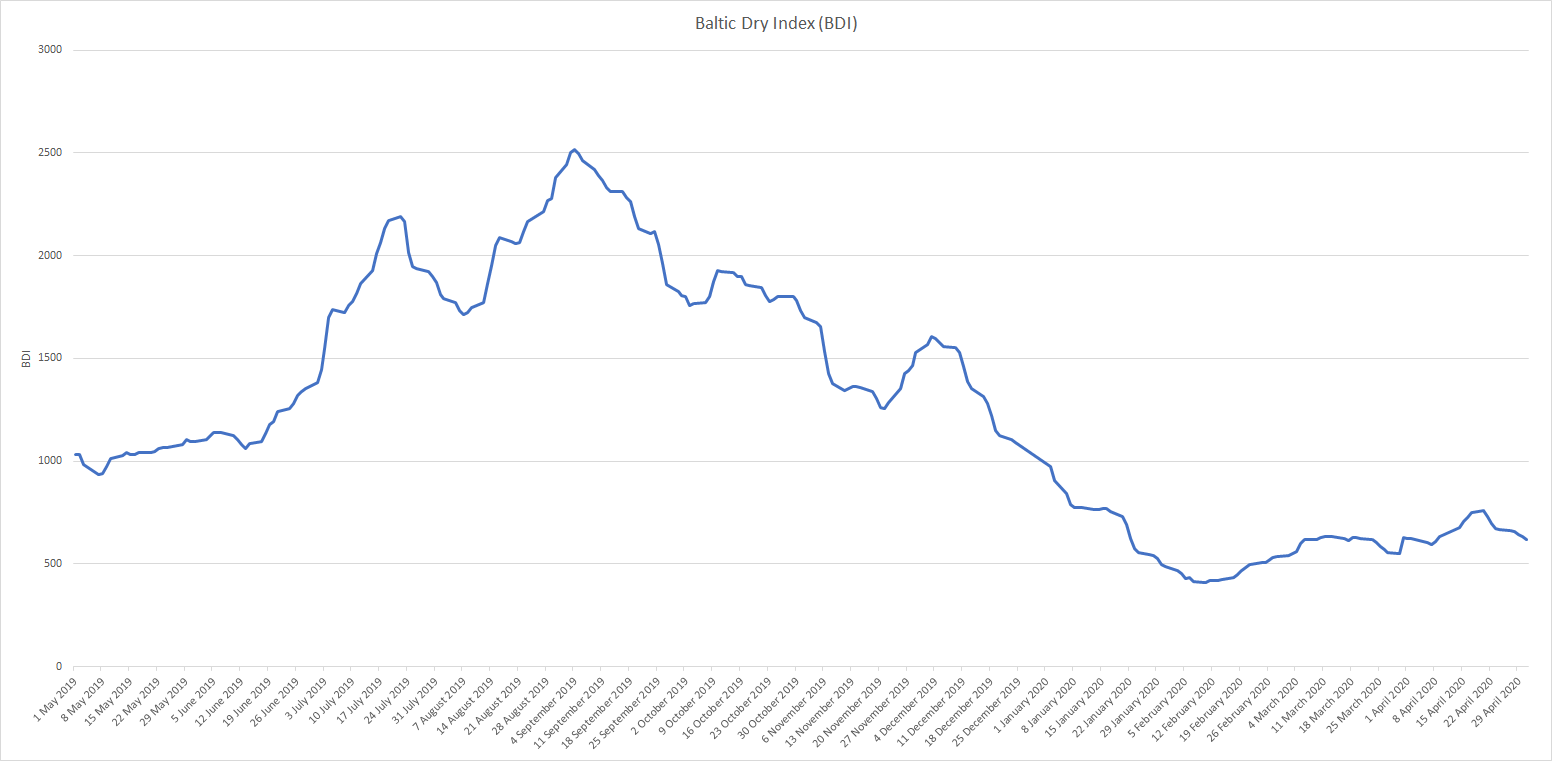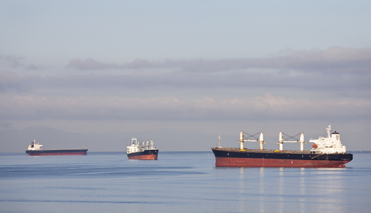BEIJING, May 4 (Xinhua) -- The Baltic Exchange has published its weekly report of the dry and tanker markets for April 27 - May 1, 2020 as below:
CAPESIZE
A tepid week for the big ships, as macro concerns continued to weigh heavily on the index. All of the major voyage routes lost value, with the exception of the C5 West Australia-China route, which traded up a modest $0.21 on the week, on a steady fixing cadence by the majors. The Pacific basin broadly remained the stronger of the two, whilst the Atlantic witnessed further weakness on Thursday, with "K" Line reported to have fixed an end May 180,000 mt Sudeste/Qingdao at $9.80, from which some in the market extrapolated a weaker equivalent $8.80/$9.00 C3 Tubarao-Qingdao.
The weakness appeared to extend to the North Atlantic too, where the Berge Stanley (2011 180,145dwt) was rumoured to have fixed the timecharter equivalent of approximately $14,500 basis delivery Rotterdam for a fronthaul, although others said that the actual number was higher – irrespective the C9 Continent/Med fronthaul route lost some $3,613 on the week. The widely-observed May Day holiday on Friday, may well offer some brief, but welcome respite.
PANAMAX
The week appeared to be one of consolidation for owners, with various holidays impacting trade. The North Atlantic appeared severely under pressure with little demand. Several short Baltic rounds were concluded - the mean nestled at around the $4,000 mark. May cargoes ex South America continued to be fixed as we enter peak period for the South American grain market with Kamsarmax types still able to achieve $10,000 delivery SE Asia/India whilst the smaller LME types around $9,000 same basis. The Pacific was very much mineral driven, with a good volume of activity from various loading areas, with coal into China and some into India again dominant. Sources suggested this was now the direction of choice, meaning rate levels to remain in the Pacific had come under a little pressure, although so far this remained very positional. Some improved activity out of South Africa on coal shipments bought some solace to the post Panamax market.
ULTRAMAX/SUPRAMAX
A more positive feel in the market during the week with the Asian arena seeing better demand, but it remains to be seen if this will continue with widespread holidays coming up. No period activity surfaced, with a wide spread between owners' and charterers' expectations. From the Atlantic, east coast South America remained fairly flat with a 63,000-dwt fixing a trip to Singapore-Japan at $11,500 plus $150,000 ballast bonus. The east Mediterranean spiked a little with a 58,000-dwt fixing a trip delivery Canakkale via Black Sea to China at $13,500 - albeit for a fairly quick trip. From Asia, stronger numbers – a 55,000-dwt was fixed from Indonesia to China in the mid $6,000s, and an Ultramax open south China fixed a round voyage with nickel ore at $7,000. From the Indian Ocean, a 55000-dwt fixed basis delivery Richards Bay trip to south east Asia at $7,500 plus $75,000 ballast bonus.
HANDYSIZE
The market saw a ray of hope for ships trading from the east coast South America this week, with more activity reported from the region. The draft in the Upriver area stopped decreasing however the tonnage list was still described as long. There was talk of some mid/large Handysize vessels fixing since early/mid of the week from south Brazil to Morocco/Continent direction in the $5,000s, which brokers considered as an improvement.
A grain house fixed a large Handysize from Paranagua for a transatlantic trip at a rate in the mid $4,000s. Meanwhile the pressure remained in the Continent / Mediterranean and US Gulf with tonnage building up. A 34,000-dwt was fixed from the US Gulf for a trip to Morocco at $4,000. In the Pacific, little demand from the Far East continued but more stems were reportedly seen from Australia. A 28,000-dwt open north China was fixed at $2,000 basis CIS for a short round trip.
CLEAN
After last week's phenomenal activity and rises in the market, this week has been less eventful and somewhat slower. However, thin availability of tonnage sees rates holding at WS500 for 75,000mt from Middle East Gulf to Japan. The LR1s, which peaked at around WS465 for 55,000mt, are presently assessed at around WS450 but brokers feel rates could be tested here. In the 37,000mt UKC to USAC trade rates eased dramatically from WS425 to sit now at around WS250 region with potential to weaken further. The market in the 38,000mt backhaul trade from US Gulf to UKC softened from WS 265 to sit now at WS 230 level and remains under downward pressure here. The 30,000mt clean cross-Med trade saw only limited activity with rates now assessed at around WS500.
VLCC
A quieter week in both Middle East and Atlantic regions has allowed charterers to regain control as tonnage availability increases, with the longer-term effects awaited of OPEC+ cuts, storage period charters and a fragile oil price alongside the shorter-term issues brought about by Ramadan and the various national holidays. In the Middle East rates for 270,000mt to China have fallen 70 points with a trader's relet reported to Unipec at WS85 while rates for 280,000mt to US Gulf via cape/cape routing also took a hammering, with a Chevron relet reported to Valero at WS40, down from WS100 a week ago. In West Africa, little activity was seen in the market for 260,000mt to China, although some of the failed fixtures from last week have been revived and renegotiated downwards with rates now assessed in the high WS90s and downward pressure continuing to be applied. There was very little activity in the Gulf of Mexico, however rate assessments have been revised to the $12m mark for 270,000mt USG/China voyages, $1.4m lower than a week ago.
SUEZMAX
Rates in this sector have tumbled, not only due to the collapsing VLCC market, but also the lack of enquiry and the small armada of cargo free vessels sitting off Gibraltar waiting for their next opportunities for gainful employment. Rates for 130,000mt Nigeria/UKCont have fallen 50+ points to WS117.5, while 135,000mt Black Sea/Med rates fell similarly to WS127 level. In the Middle East market, the focus has been on trips to the Far East where rates have come off, therefore sentiment alone has driven rates down 35+ points for 140,000mt Basrah/Med to low WS90s. However, this level is yet to be tested.
AFRAMAX
Rates within Europe peaked and fell quite dramatically in the latter part of this week. 80,000mt Ceyhan/Med is now at WS172.5-175 level, down almost 60 points, while 80,000mt Cross North Sea is now WS155, a drop of 82.5 points and 100,000mt Baltic/UKC saw a similar capitulation to WS125-127.5 region. Across the Atlantic, rates for 70,000 Carib/US Gulf fell a modest 7.5 points to WS215 and 70,000mt US Gulf /UK Continent dipped about five points to WS187.5-190 level.
Headquartered in London and a subsidiary of the Singapore Exchange (SGX), the Baltic Exchange publishes a range of indices and assessments which provide an accurate and independent benchmark of the cost of transporting commodities and goods by sea. These include the Baltic Dry Index (BDI), the dry bulk shipping industry's best known indicator. Published daily since 1985, this provides a snapshot of the daily spot market earnings of capesize, panamax and supramax vessel types on the world's key trading routes.

Chart shows Baltic Dry Index (BDI) during May 1, 2019 to Apr. 29, 2020
In March 2018 the BDI was re-weighted and is published using the following ratios of timecharter assessments: 40 percent capesize, 30 percent panamax and 30 percent supramax. The information is provided by a panel of international shipbrokers.
(Source: The Baltic Exchange, edited by Niu Huizhe with Xinhua Silk Road, niuhuizhe@xinhua.org)




 A single purchase
A single purchase









